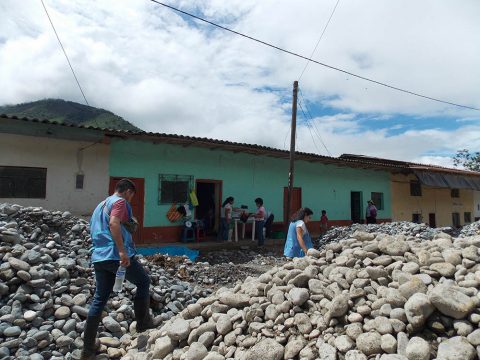The Community Health Perceptions Study is one of the baseline studies of the COHESION project. It consists of a community mapping, focus groups and in-depth interviews with the aim to understand the community’s perceptions on healthcare services, health problems, (especially those related to diabetes, hypertension, and neurocysticercosis), as well as the implications of NCDs and NTDs at the individual, family and community level.
The community mapping in Peru was conducted in November 2016 in rural and peri-urban communities located in Northern Peru, namely: Ayabaca, Montero, Pingola and Sicacate. The fieldwork team was composed of one representative of CRONICAS Center of Excellence in Chronic Diseases (Silvana Pérez León) and a member of its local partner Centro de Salud Global of Universidad Peruana Cayetano Heredia (Fernando Urizar). They visited the selected communities and identified relevant actors to engage with in future COHESION activities.
This first visit helped to gain an overall understanding of the communities as well as to plan the data collection process, which took place earlier this year (February 1-21). Data were collected by two teams comprised of a man and woman with social sciences degrees. They were joined by Nathaly Aya Pastrana, the COHESION PhD student from Università della Svizzera italiana in Lugano Switzerland. Nathaly participated in interviewing patients, caregivers and community leaders, as well as conducting focus groups with community members.
Data collection during the rainy season was challenging as the heavy rains made it difficult to access remote areas and to recruit participants for the focus groups. Intense rainfalls and floods continued until April 2017, creating public health concerns in the region, such as the spread of infectious diseases like dengue (Ministerio de Salud del Perú 2017). Fieldworkers (Gabriela Rengifo Briceño and Jorge Tuanama Álvarez) shared the following testimony of their fieldwork experience in the area:
“The dispersion of the population and the rains represented a challenge, but we learned that these are everyday conditions that people must solve when going to work, going to the health post for a checkup or for an emergency. Some are critical of the health service but it is the nearest alternative. Besides, going to other providers is expensive in time and money. Therefore, it was difficult to talk about health without offering in exchange attention, medicines or information.”
Ms. Aya Pastrana collected additional data through 1) interviews with representatives of communication channels, 2) recorded radio programs, 3) collected samples of printed communication material from local primary health care centers, and 4) documented observations of her field experience. The findings will provide additional insights to design interventions at the community level.
Preliminary analyses of the Community Health Perceptions Study show differences in the awareness about chronic conditions. People seem more aware of hypertension, with little knowledge of diabetes and neurocysticercosis. (see COHESION Newsletter Vol.1 Ed. 1)
References:
Ministerio de Salud del Perú (2017) Aprueban “Lineamientos Para El Manejo Del Dengue En Zonas de Desastres Perú 2017.” http://www.minsa.gob.pe/?op=51¬a=22577, accessed July 20, 2017.

Interview with patient for the Community Health Perceptions Study, Sicacate, Northern Peru.
![]()

Focus groups with old women for the Community Health Perceptions Study. Pingola, Northern Peru.

Recruiting participants for the Community Health Perceptions Study. Montero, Northern Peru.

Recruiting participants for the Community Health Perceptions Study. Montero, Northern Peru.
